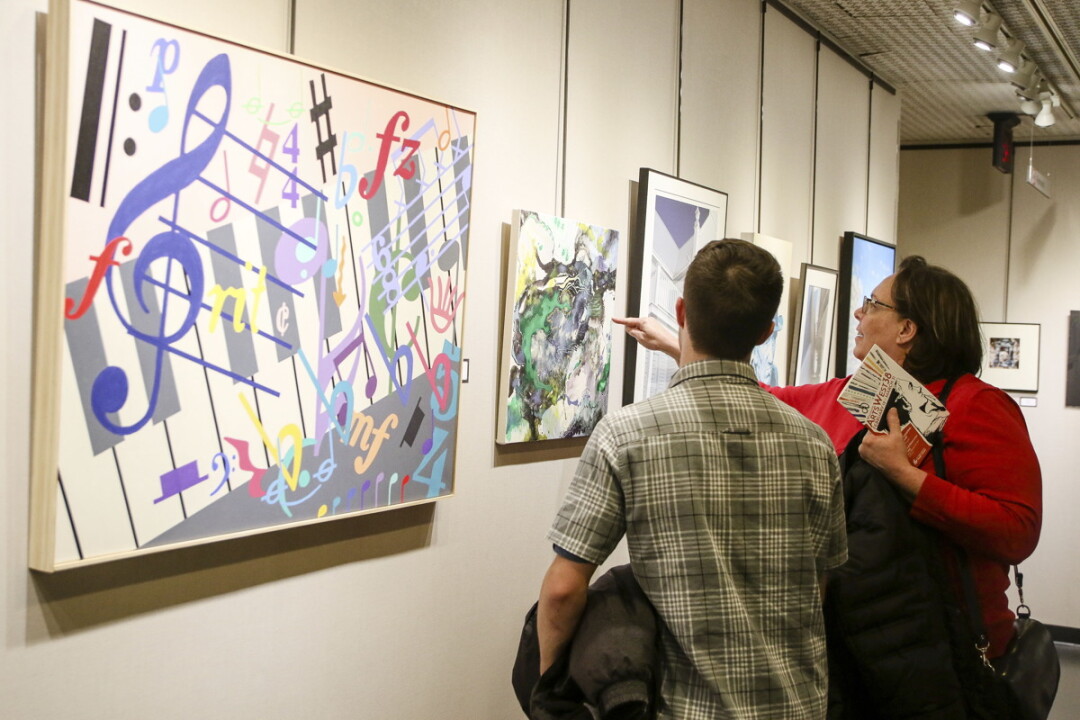Sandpipers in the Gallery
art appreciation can require changing your perspective – literally and figuratively
Katie Venit, photos by Andrea Paulseth |

‘I like to look at a piece far away, I like to look at it close up, and the last thing I look at after a piece has grabbed me is the title,” said Amy, as we pendulate in front of a painting like two sandpipers in the ocean surf. Amy (full name: Amy Hahn; profession: art therapist) agreed to teach me How To Appreciate Art. Earlier this year, the ArtsWest 38 juried group show in the library gallery (full name: L.E. Phillips Memorial Public Library; profession: library) seemed like a logical spot to appreciate a variety of media: photographs, abstract oil paintings, portraits, sculptures, and more.
I didn’t get much from the first painting we stopped at, and Amy said that’s OK. Art is subjective. “Some art isn’t for everyone. ...I don’t hold still on pieces that don’t initially grab me and pull me in,” she said.
“The first time you go to an art gallery you can be like, ‘Meh, OK.’ And then the more you go to them, you start thinking about them more, and holding still on pieces more, and talking about them. All of a sudden you realize that this is pretty interesting.” – Amy Hahn, artist and art therapist
Amy would know something about pulling people in. She’s also an artist. Her pieces invite viewers to pick them up and engage with them (although, it’s important to remember that most artists prefer a hands-off policy). Amy herself draws people into her positive aura, and the more we walked around the gallery, the more I caught her enthusiasm.
We sandpipered with another charming piece. Close up, I could see the skill the artist displayed dabbing on the paint. The strokes themselves were quite pretty. Far away, those disparate strokes worked together to form a meandering river with a mirror finish, reflecting the trees overhead. But with the title, “Flooded Tote Road,” the river threw off its disguise and revealed itself to be a rural road covered by standing water.
“Reading the title can change it all,” she said, explaining that is why she looks at it last. “It’s fun to tell your own story about a piece first.”
“We had an initial impression, looked at it far away and close up, and then looked at the title, and voilà, you had an experience that’s not tied to your phone or your kids or your busy life, and made you hold still and have an experience outside of yourself,” she said.
We held still at another painting by the same artist. At first glance, it depicted a serene summer’s day on a lake in the same impressionistic style. But the title, “Calling Raven,” made us reconsider. A raven perched on a riderless canoe, floating away from shore. As the title focused our attention on the cawing bird and the canoe’s dark interior, we were both led to the same conclusion: Far from being a serene lake scene, this image symbolized death.
Next, an abstract painting. I felt lukewarm about it; I didn’t dislike it, but it didn’t call me to hold still. Amy explained that when abstract art was first presented way back when, context was key. In order for an audience to truly appreciate a simple square on a canvas, they needed to know why that square was revolutionary in the first place. But now, context may not matter as much for contemporary pieces.
“At this point, because so much has already been done and it just cycles in on itself, the weight of an abstract art piece doesn’t hold as much as it did when abstract art first came out. It’s been done so many times,” she explained.
“You know right away when it hits all the right notes and when it doesn’t. For example, compare this piece,” she said, pointing to the lukewarm piece, “to that piece.” She gestured a few feet away to another abstract painting.
“Oh,” I said, feeling as satisfied as when I’m watching a Facebook video of a master pastry chef decorating a cake. The colors were not my favorites – in fact, I preferred the colors of the first piece – but the colors coordinated so well together that they felt soothing. We stuck our noses close to the canvas and could see the artist’s skill in each careful stroke.
Amy also told me to notice the frame of a painting, the scale (smaller pieces force viewers to bob closer to the work, drawing them in), and whether the piece continues off canvas or is contained in the frame. All of these elements add up to the piece’s story.
“The first time you go to an art gallery you can be like, ‘Meh, OK.’ And then the more you go to them, you start thinking about them more, and holding still on pieces more, and talking about them. All of a sudden you realize that this is pretty interesting.”
The next time I go to a gallery, I’ll take Amy’s lessons along with me, if not Amy herself, as I continue to contemplate an empty canoe and a calling raven.


















